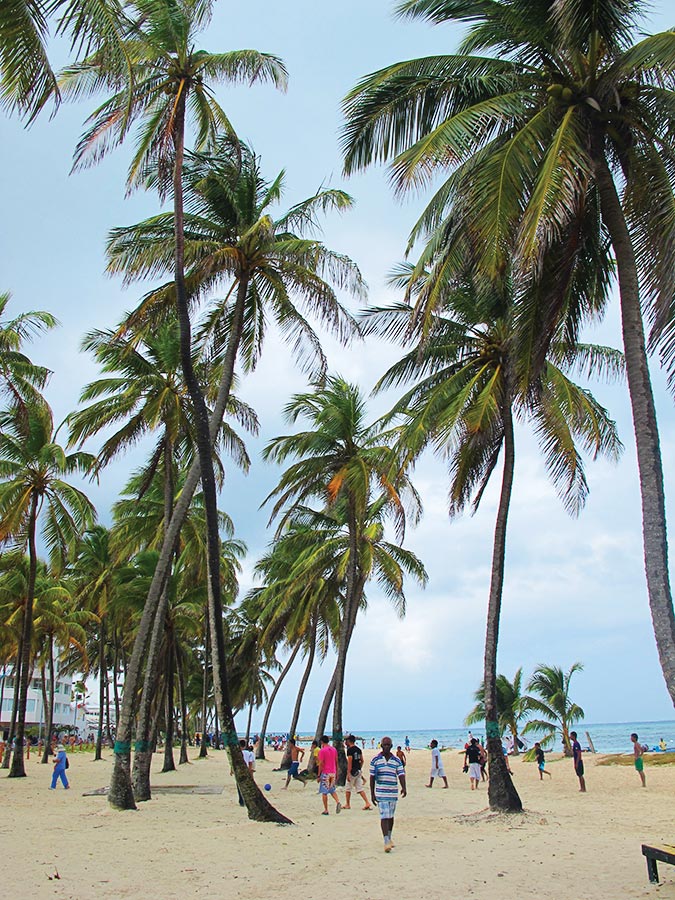For many, their first stop in San Andrés after checking in to their hotel is the Spratt Bight Pathway (Centro). This pedestrian walkway is the liveliest stretch on the island, lined with restaurants, hotels, and souvenir shops on one side. On the ocean side of the pathway is the island’s most popular beach, Spratt Bight, which looks out toward the enticing Johnny Cay in the distance.

The beach at Spratt Bight. Photo © Andrew Dier.
It would seem that all caves hidden along the coasts of San Andrés and Providencia are reputed to hold hidden treasures stashed away by notorious pirates. On the western side of San Andrés is Cueva de Morgan (Morgan’s Cave, tel. 8/513-2946, 9am-6pm daily, COP$10,000), a sort of theme park where Welsh privateer/pirate Captain Henry Morgan allegedly stored some of his loot (but there’s no evidence to prove this). There isn’t much to see at the cave itself. That’s why the park owners added on some reconstructions of traditional wooden island cabins that serve as mini-musuems on island culture and ways of life. You visit these on a guided tour that is included in the cost. One is an art gallery where local dancers often perform to calypso beats. All in all, it’s a tourist trap.
At the Hoyo Soplador on the island’s southern tip, the attraction is a hole in the coral where, when the tide and winds are right, water sprays up, reaching heights of more than 10 meters. It can’t compare to Old Faithful, but then again, can you order a coco loco in Yellowstone?
The Jardín Botánico (Vía Harmony Hill in front of Hotel Sol Caribe Campo, tel. 8/513-3390, 8:30am-5pm Mon.-Fri., 10am-4pm Sat.-Sun., COP$5,000) is easily the most peaceful place on San Andrés. In this lovely botanical garden run by the Universidad Nacional, you can stroll along several paths and view trees and plants that grow in San Andrés. From the five-story lookout tower, you can take in an impressive view of the island and its barrier reefs. Guided tours, included in the price of admission, are technically required, but if you are in a hurry or arrive in the late afternoon, you can request to amble the trails unaccompanied.
The white, clapboard First Baptist Church (La Loma, no phone, services 7:30pm Thurs. and 10:30am Sun., COP$3,000 donation requested) was built in 1844 and rebuilt before the turn of the 20th century using wood imported from Alabama. It was the first Baptist church established on the island. A guide will give you a little history of the church and allow you to climb up to the bell tower for a commanding view of the island. The Sunday worship service can last several hours. Church members dress up for services, and you’ll often see a smattering of tourists in the balcony on Sundays. The church is an excellent place to hear gospel music.
Job Saas, a local Raizal man, operates Paradise Farm (Cove Seaside, Km. 11 Polly Higgs Rd., tel. 8/513-0798, cell tel. 315/770-3904, donations accepted). Saas decided to transform the former standard family farm into one with a focus on conservation and the environment. Here you can see animals, such as iguanas and turtles, and plants that are threatened due to overdevelopment on San Andrés. Saas uses the same farming techniques that his family has used for decades. It is a great initiative on this island where environmental awareness is lacking. He welcomes visitors to the farm, and, if you are lucky, you can hear his band play.
Managed by a Rastafarian community, the Big Pond (La Loma, no phone, no set visiting hours, donations requested) is a pond on the top of La Loma, home to a few domesticated alligators. When called, they will swim close to the shore, where they are fed a diet of white bread. The alligators live in harmony with turtles, and herons watch the action from a tree nearby. Upon arrival, ask for Fernando. There is no set entry fee.
Excerpted from the First Edition of Moon Colombia.